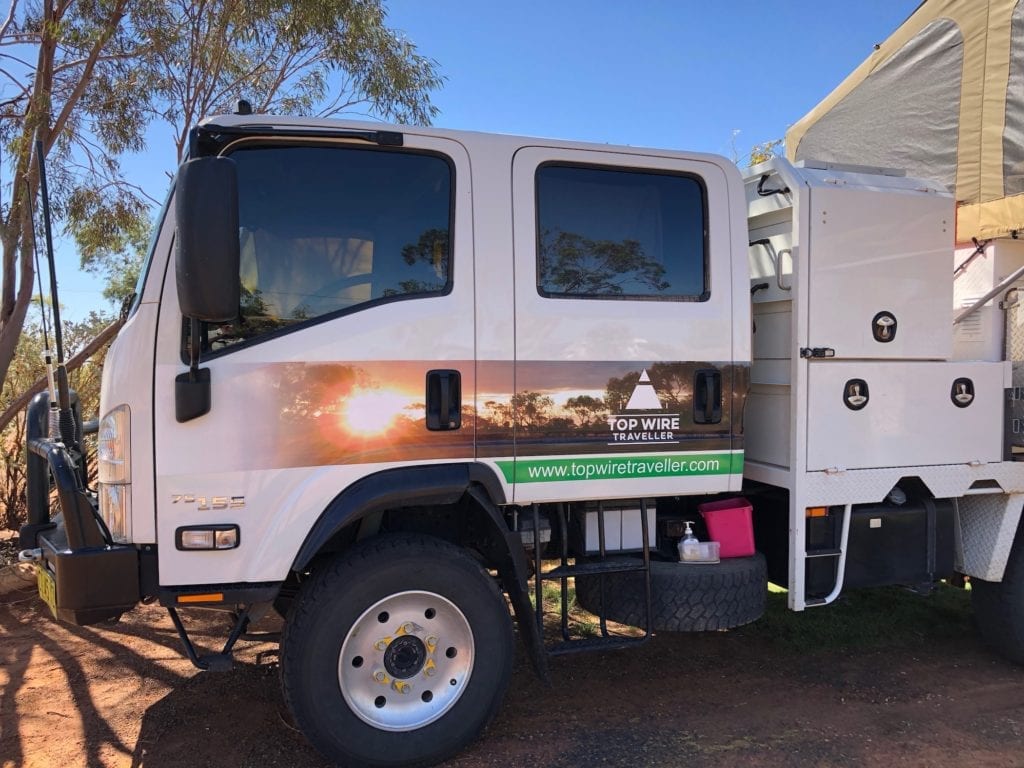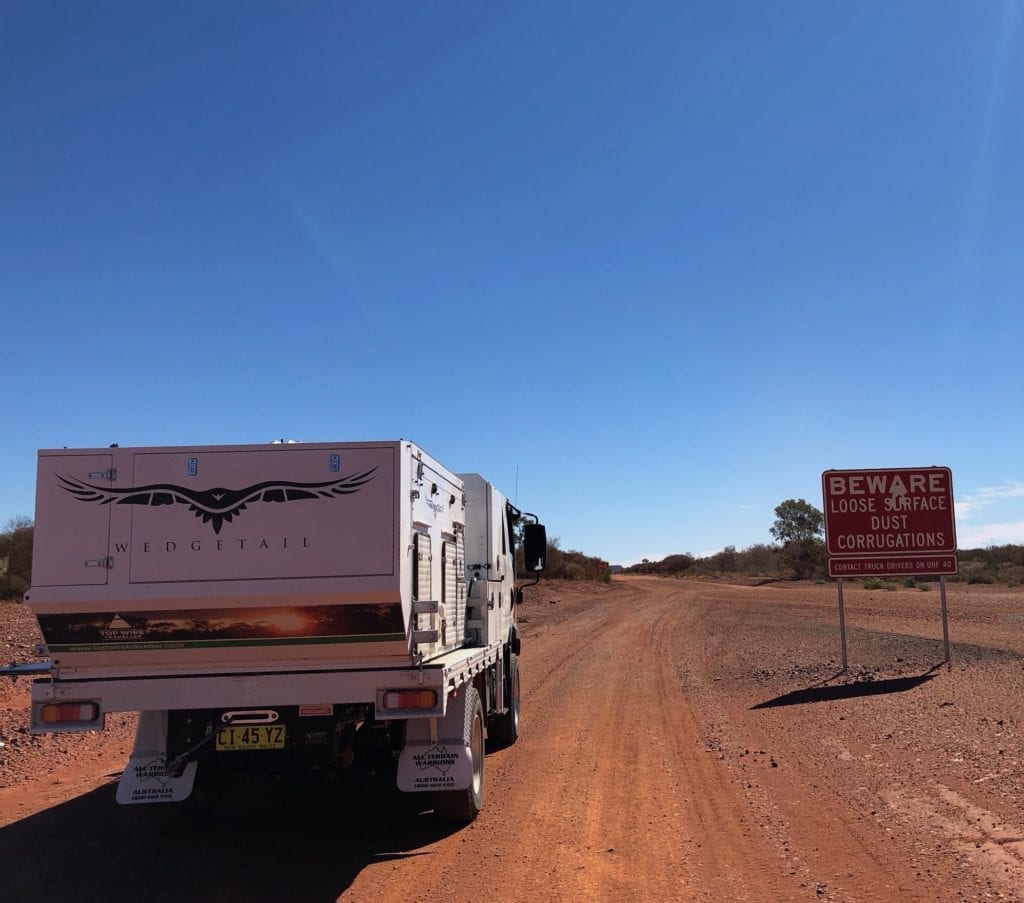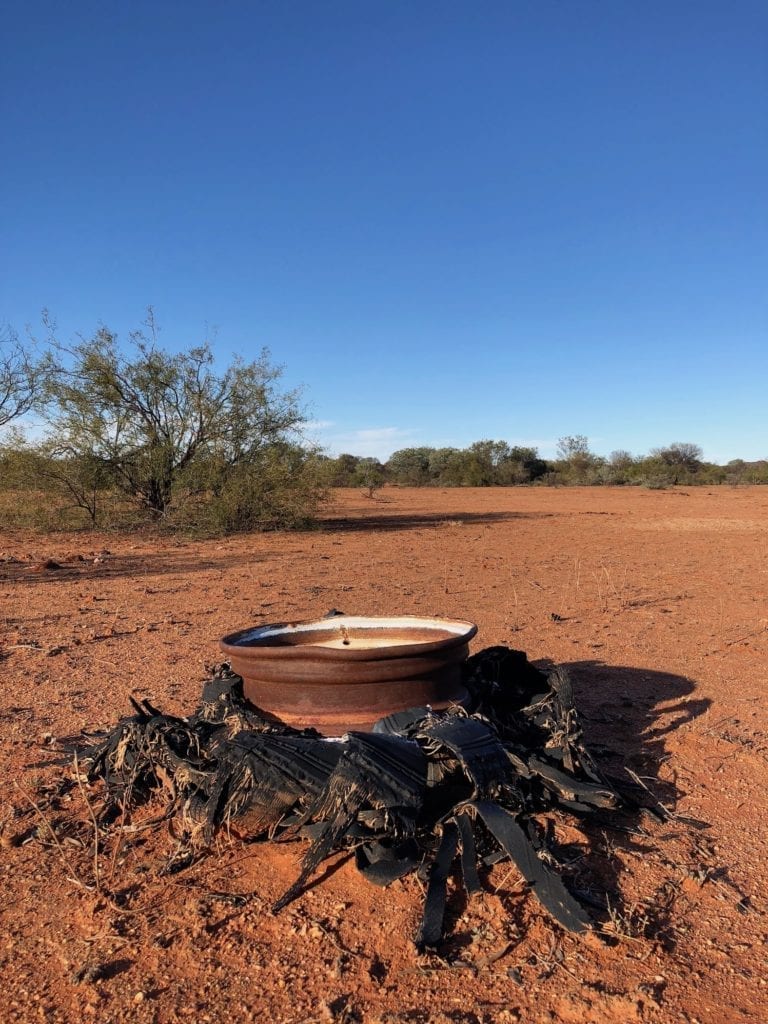Where do you start with tyre pressures? There’s so many variables to deal with, especially with a light 4×4 truck. Freeway bitumen, badly cambered and rough bitumen, smooth dirt roads, rocky and corrugated dirt roads, deep sand, mud…
How do you find a balance between tyre wear and comfort?
We’ve had lots of questions about tyre pressure. So what follows is our experience to date and what we’ve learnt.
Our Tyres
We’re running Toyo M608Z truck tyres 285/70/19.5. These Toyo tyres are covered in detail here.
Update: As of 2022, unfortunately Toyo has stopped importing truck tyres. So the tyres described here are no longer available in Australia. We are currently trialling a set of Founders 305/70R19.5 mud tyres.

How To Figure Out Correct Tyre Pressure?
This question is answered in detail here. However it’s worth summarising.
We recently ran our truck over a weighbridge fully loaded. We’re running at 6.58 tonnes, with the Wedgetail Camper, fuel, water and all our gear. Our weight is distributed as 2.78 tonnes over the steer and 3.80 tonnes over the drive.
We had settled on two sets of tyre pressures, one for bitumen and one for dirt/off-road (cold pressures quoted here):
- On bitumen we were running 85psi rear and 75psi front.
- On dirt roads or off-road conditions we were running 60 rear and 60 front.
We spoke to Steve Burke, Technical Manager at Toyo Tyres Australia about our tyre wear and the best pressures to run. Based on us running long distances on bitumen, dirt or a mix of both, he recommended (cold pressures):
- On bitumen, run 85psi rear and 65psi front.
- For general off-road use, run 70psi rear and 50 front.
Update: We have reduced rear tyre pressure to 60psi (cold), as the ride was too rough at 70psi.
We’ve now dropped both front and rear pressures again. The ride is infinitely better on rougher roads. The tyres don’t seem to get any hotter either. So the new figures are:
– For general off-road use, we run 55psi rear and 45psi front.
Steve had some excellent advice for all of us. He said, if in doubt always contact your tyre manufacturer for expert inflation advice. They should be more than happy to advise you on correct pressures for your truck.
And remember, the tyre pressures that suit your set-up will be different to ours. This is why you really should talk to the tyre manufacturer for professional advice.
What’s The 5psi Rule?
For cars and 4WDs, if the difference between cold and hot tyre pressure is around 5psi in a given tyre, then your pressure is somewhere near the mark.
It’s simply a good guide… a quick rule of thumb and easy to check.
Heat build-up in a tyre is causing by the casing flexing. If your tyres are over-inflated, the casing will flex less. So you’ll hardly see any difference between cold and hot tyre pressures.
If your tyres are under-inflated, the casing will flex more. You’ll generate more heat and there’ll be a significant difference between cold and hot tyre pressure.
For our truck, we use 5-6psi as a rough guide. It’s a simple way to check whether the tyres are getting too hot. The last thing we want is a blowout!
Airing Down On Dirt Roads
We always air down on dirt roads. If we didn’t, we’d shake the truck and ourselves to pieces. So this is a pretty good incentive to air down!
Just as importantly, a lower tyre pressure allows a tyre to mould itself over rocks and sharp objects to some extent. Think of a balloon. A fully inflated balloon is easily popped. However, a partially inflated balloon is not so easy to pop. The same applies to your tyres.
Now some people think they can air down on dirt then drive like they stole it, with no consequences. Not true.
Slow down. It’s that simple.

Don’t go over 80km/h on dirt roads. Yes, even good dirt roads. They are unforgiving. You only have to hit one pothole or washout and the next thing you know, you’ll be in the scrub.
Even if you’re lucky and stay on the road, what damage are you doing to the tyres and suspension?
We’ve always stuck to this rule in all our vehicles and never experienced a single flat tyre, blowout or any suspension damage. Not only that, this lower speed gives you more time to avoid suicidal emus, kangaroos, pigs, goats, sheep and cattle.

One last tip. Your tyres aren’t bulletproof. Try to avoid larger stones, sharp rocks and sticks. This is much easier to do at 80km/h than at 100km/h…
Airing Down In Sand
So far, we haven’t needed to. However, we haven’t done any beach driving yet.
We’ve driven through some quite deep, hot and dry desert sand though. Sandy two wheel tracks through and over sand dunes. We left our tyres at 60psi front and rear as an experiment. The truck just floated on top of the soft sand, with no issues at all.
The worst part about driving in these conditions is you can’t avoid the dreaded mulga and gidgee sticks. They’re generally poking out of the sides of the wheel tracks, just waiting to pierce any passing sidewalls. Happily, we had no marks, nicks or cuts on our sidewalls at all. I suppose this is one advantage of running a heavy truck tyre.
I know a few people who have run these tyres down at 20psi in soft, dry beach sand on Fraser Island in Queensland. Obviously at these pressures, you have to be careful.
In Summary
Tyre pressure depends on your truck’s weight and what surfaces you’re running on. Take your truck over a weigh bridge then get in touch with your tyre manufacturer.
Slow down on the dirt and take it easy. Your truck and tyres will last much longer if you do!

Get your Traveller’s Guides
… and a whole lot more at our FREE RESOURCES Page!
Any questions or comments? Go to the Comments below or join us on Pinterest, Facebook or YouTube.
Any errors or omissions are mine alone.
NOTE: We are not affiliated with Toyo Tyres Australia. Thanks to Steve Burke from Toyo Tyres Australia for his help.
Go here for more How-To Guides and tips.


Thanks for all the information that you have provided You are a great inspiration to all of us who follow in your footsteps We will be NPS ing by mid 2020
Thanks Ed & Jude! Hopefully we’ll see you out on the road somewhere.